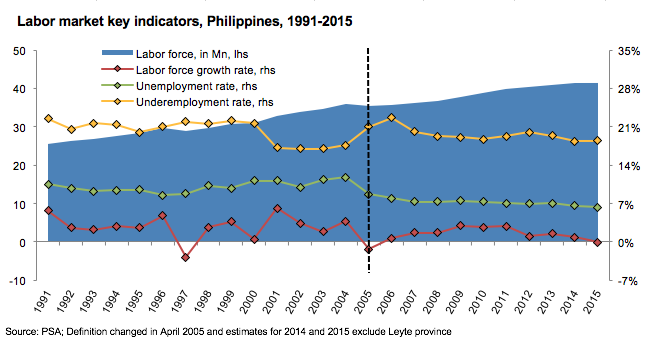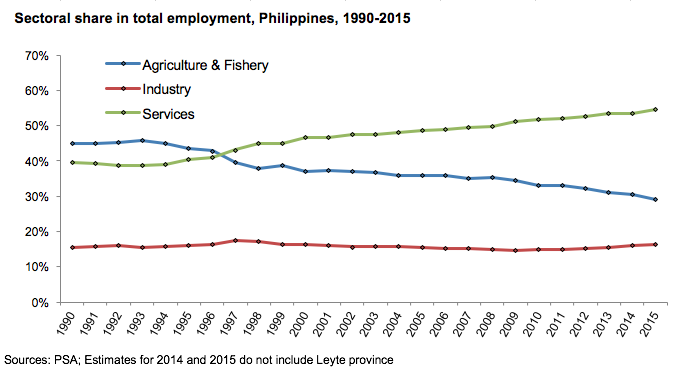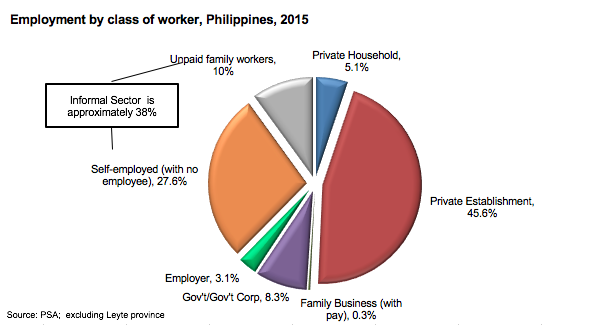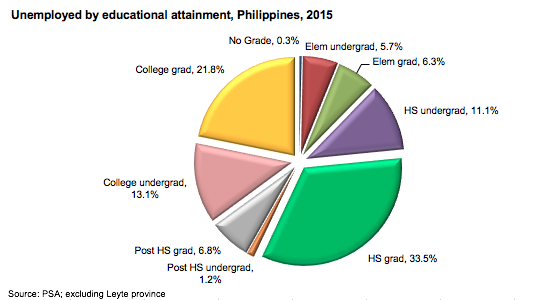Inadequate Skills + Insufficient Jobs = High Unemployment/Underemployment
Creating new jobs and training workers and students with skills needed in existing and emerging labor markets are the two most serious challenges for the Philippine economy in the next two decades.
Figure 13 shows the Philippine labor force of 38 million has increased by more than 50% since 1990. The combined unemployment and underemployment rate exceeds 25%.11 Figure 14 shows percentage changes in the distribution of the work force between agriculture, industry and services over the last two decades. As part of an economy’s growth, industry usually absorbs excess labor from agriculture, but this is not happening in the Philippines. Instead the share of services is rising as a result of the growing retail sector supported by increasing remittances.
Figure 13: Labor market key indicators from 1991 to 2015
Source: PSA; Definition changed in April 2005 and estimates for 2014 and 2015 exclude Leyte province
Figure 14: Sectoral share in total employment from 1990 to 2015
Sources: PSA; Estimates for 2014 and 2015 do not include Leyte province
Figure 15 shows that 43% of the workforce in 2009 is in the informal sector, where most work in low-paying or unpaid labor activities.
Figure 15: Employment class by worker, 2015
Source: PSA; excluding Leyte province
Figure 16 shows the level of education of the unemployed with very high percentages having attended college (22%) or being college graduates (19%). The high level of college students who are unemployed strongly suggests they are not acquiring the right skills needed by employers, that there is insufficient investment in the economy, and, possibly, that minimum wages are too high when compared with other countries in the ASEAN-6 (see Part 4 Business Costs).
Figure 16: Unemployed by educational attainment, 2015
Source: PSA; excluding Leyte province
In early 2010 the National Competitiveness Council (NCC) released a study calling on the country to create 15 million “quality” jobs in the next five years. The study observed 3-4 million new jobs a year are needed to reduce the unemployment rate to the East Asia average of 2-6% and to eliminate underemployment. The NCC urged that the GRP adopt a “sound industrial policy for job creation” with a focus on manufacturing.
A recent projection (see box below) forecasted a 50% increase in the country’s labor force by 2030 to 52 million. Even with continued access to overseas job markets, the economy will need to attract substantial investments to create new domestic jobs.
The weak employment situation has prompted increased calls for social programs to support informal sector workers. In late April a coalition of non-governmental groups12 proposed that the 15th Congress extend social protection to marginalized sectors under a People’s Social Protection Agenda. The group claimed informal workers comprise 25 million or 77% of the workforce, are not covered by social security, and are inconsistently covered by health insurance. The group seeks decent jobs for all Filipinos, urging improved productivity in agriculture, which employs about a third of the country’s workers. It recommended a Magna Carta for Workers in the Informal Economy who account for almost half of GDP. Also proposed were unemployment insurance, universal health insurance, emergency employment, grassroots microinsurance and microfinancing, strengthening of social security, and affordable housing for all.
“In the Philippines… unemployment is a ‘time bomb’. Between 2005 and 2030, the labor force will increase from about 32 million to 52 million… will the economy be able to provide jobs? Skills mismatch and the lack of human capital are also the most commonly cited reasons of unemployment . In reality, the systematic failure of the economy to create enough jobs is the main cause of massive unemployment.”
“Employment is a basic right and full employment should be the primary objective of economic policy… Nobody willing and ready to work for just a wageshould be without a job. Society must be able to provide jobs for all…And they should be able to provide jobs for the workers they have and not for the workers they wish they had,” Dr. Felipe added, “A full employment economy offers a great number of advantages… reduced need for a societal safety net, lower social costs, and a higher political stability… immediate policy priorities to achieve full employment should be population management and job guarantee programs. Industrialization policies are also crucial.Eductaion does matter for long-term growth, but it is not a key constraint now… Individuals cannot be left out and stigmatized for being ‘uneducated’.”
—Philippine Institute for Development Studies(PIDS) press release quoting Asian Development Bank(ADB) principal economist Dr. Jesus Felipe, author of Inclusive Growth, Full Employment, and Structural Change: Implications and Policies for Developing Asia, April 20, 2010.
Footnotes
- The definition of employed includes persons 15 years old and above who work at least one hour per week for pay or profit or in a family enterprise. [Top]
- The University of the Philippines School of Labor and Industrial Relations’ Center for Labor Justice, College of Social Work and Community Development Social Protection Cluster, Fair Trade Alliance, Association of Construction and Informal Workers, Magna Carta for the Informal Sector Alliance, Homenet Southeast Asia and Homenet Philippines. [Top]































